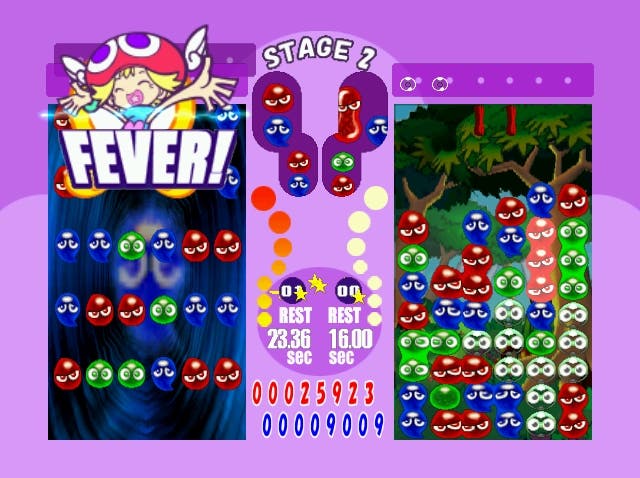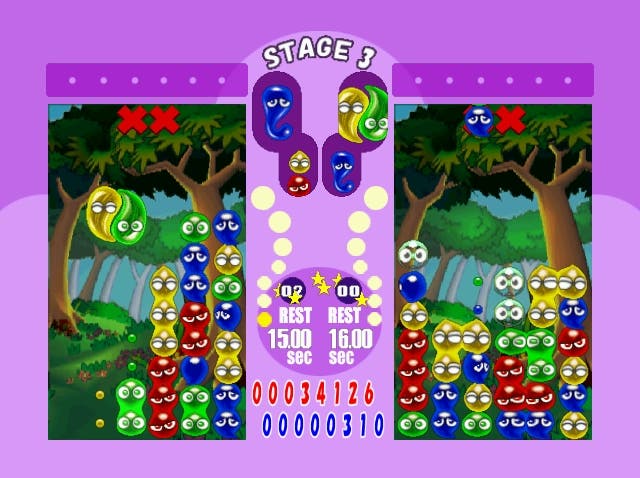Puyo Pop Fever
Pop goes the Sega.
When the common man thinks about videogames, several images flash through his Neanderthal head. One of them is a little yellow dot munching pills in a maze. One of them is a little spaceship firing upward as rows of insectoid aliens dance from side to side. And one of them is a series of geometric shapes falling down the screen and disappearing with each completed row. It's difficult to compete with that sort of inherent genetic marketing.
Puyo Boy!

Sega's Sonic Team, however, has always been up for a challenge, and that appears to be just what they're facing with Puyo Pop Fever, a subtle reworking of one of those classic puzzle games unflatteringly dubbed "Tetris clones". Due in February next year on PS2, Xbox and Cube, it takes the original Puyo Pop formula - red, blue, green, yellow and purple blobs (known as Puyo) drop down the screen and disappear when positioned adjacently in groups of four or more - and gives it a few bells and whistles, not to mention colourful anime-inspired visuals.
In addition to the classic Puyo Pop with no time limit or other distractions, players can now expect an opponent to contend with in most of the single-player modes and of course in the ever-addictive multiplayer game. As well as manipulating Puyo into groups of four, this time you'll have to really consider chain-building (the art of vaporising large groups of Puyo with one carefully planned "pop"), because along with the expected big points total, you'll also be sending plenty of Nuisance Puyo over to your opponent's side of the screen.
Nuisance Puyo are exactly that - and they can really hinder your progress if they land in amongst your carefully constructed chains. However in order to stave off their effect, it's also possible to counteract them. See, when they're first generated by your opponent, Nuisance Puyo are stored in a sort of preview pane above your screen, and if you can set up your own chain reaction in the short time they spend in the preview pane, then you can counter-attack and send them back - a technique known as "offsetting".
Pop culture

Offsetting is something you'll get used to because it in turn fuels the Fever Count and each player's Fever Time. When the Fever Count is full, the game kicks into the titular Fever Mode, in which readymade chains drop from the sky and have to be positioned to gather as many chain reactions as possible before the Fever Time runs out. Either highly lucrative or highly damaging by the sound of it.
Sega tells us that multiplayer is definitely "where it's at" on this one, but single-players are thoroughly catered for as well, with three increasingly difficult sets of stages to overcome using each of the game's quirky characters - Amitie the cheerful, balanced all-rounder, Raffine the chain-building advanced character and Ms. Accord the slow-burning, chain-building professor - and a Free Battle mode. Furthermore, an "Endless Puyo Pop" menu offers several specialised game modes - Fever (Fever Mode only game with successful chains extending Fever Time), Mission (Puyo removal missions set against the clock) and Original mode (the original Puyo Pop game with no distractions).
In the Double Puyo Pop (two player) multiplayer mode, there are options for Classic rules too, as well as normal Fever-tinted rules and Trap Rules - effectively a reversal, which nullifies Fever Mode power and turns it into more of a disadvantage.
Fever pitch
Puzzle games don't always take hold when it comes to full console releases, but we've always had a soft spot for Puyo Pop's brand of peculiar anime-inspired quirkiness, ever since American imported carts of sanctioned rip-off Kirby's Avalanche throbbed in our Super Nintendos. When Puyo Pop Fever turns up in the near future, we'll be sure to let you know how it, er, stacks up.

